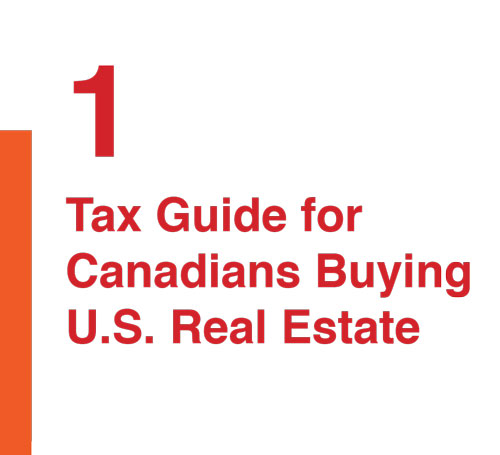
There are five methods Canadians can consider when buying U.S. Real Estate.
1. Limited Liability Corporation (LLC)
An LLC allows for limited liability protection. This means that in the event of a lawsuit, your personal assets are not at risk. Also, an LLC does not pay any income tax as its shareholders are responsible for all tax liabilities. This works well only for U.S. citizens. LLCs do not work well for Canadians because they are treated as foreign corporations by the CRA (Canada Revenue Agency).
2. Under Your Own Name
In this case, you will file a U.S. tax return known as the 1040-NR. While you pay tax in the U.S. on the net rental income, it will also be reported on your Canadian return. You will not be double taxed, as you will receive a foreign tax credit on your Canadian personal tax return for the U.S. taxes paid.
3. With a U.S. Partnership
This structure has three main components:
> A limited partnership that owns the American property
> A Canadian corporation that is a general partner in the limited partnership


> An individual investor (limited partner)
What’s great is that the partnership does not pay tax, but the investors are responsible for paying all tax liabilities. Any U.S. taxes paid will be credited to you on your Canadian personal tax return.
4. Through a Canadian Trust
This structure involves a settler and the trustee(s). The trustee(s) can use the funds from the trust to acquire real estate assets which will be registered under the trust’s name.
5. C-Corporation
Generally, this is a good structure to acquire many different assets. Unfortunately for Canadians buying real estate, it is not one of them. This is because of the number of different taxes that will be imposed.
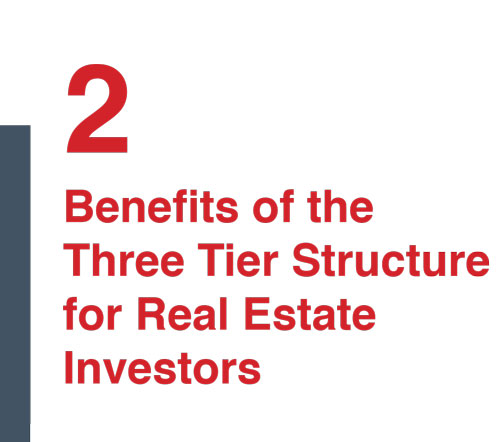
Are you wondering what are the benefits of using the three-tier structure? The three-tier structure is designed for and used by real estate investors. The three-tier structure is as follows:
The Three Corporations
> A Management Corporation
> A Real Estate Company
> Holding Corporation
The management company provides property management services to the real estate company in turn for a fee. The real estate company owns land and buildings. The holding company behaves like a piggy bank and owns 100% of the shares of the real estate company. The term “piggy bank” is used because the real estate company distributes cash dividends from its rental profits to the holding company on a periodic basis.
Benefits
> The management company pays a very low rate of tax of only 12.5% on business profits
> The real estate company has reduced risks for lawsuits because it’s not performing any property management services


> The holding company protects cash retained earnings from creditors
So Here’s The Tip
If you are a serious real estate investor, use the three-tier structure to reduce legal risk, protect cash, and lower your tax bill.

If you own real estate in Canada, and have sold or are thinking of selling, you can save thousands with these helpful tips.
How to Reduce Taxes on the Sale of Real Estate in Canada
> Call the profit you made on the sale of Canadian real estate a “capital gain”
> Maximize a number of capital improvements to reduce taxes on property sales
> Do not Claim Capital Cost Allowance
You should calculate the capital gain on the sale of your real estate, maximize the number of capital improvements to your property and factor in the Capital Cost Allowance.
Best Ways to Own Canadian Real Estate Investments
> Sole Proprietorship
> General Partnership
> Limited Partnership
> Corporation
There are different ways to own your real estate investment as mentioned above. The best structure depends on your personal circumstances. Consult with your accountant before buying real estate, to make sure that you do it the right way.


Tax Implications of Changing Your Primary Residence into a Rental Property
When you begin renting your home, there is a change in the use of your property for tax purposes. The CRA deems you to have sold your home to yourself for its market value at that time. Changing your home into a rental property is not a tax-free event. A capital gain can result. To reduce taxes, claim the principle residence exemption if you qualify. Always consult your accountant before converting your property into a rental.
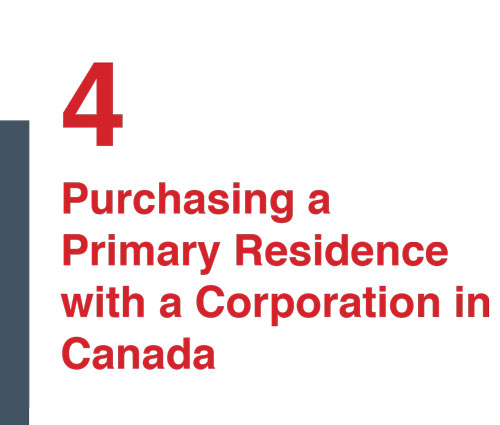
Suppose that you would like to buy your dream home, but your corporation holds all your savings. If you withdraw all of your savings, you will get hit with a huge personal tax bill, which you want to avoid at all cost. So what should you do?
Using the following strategy, you can utilize your corporate savings to purchase your new home without paying any personal tax. Let’s consider you incorporate a company called House Inc. You also have an existing company called Money Bags Ltd.
Step 1: Incorporate a Canadian company either federally or provincially called House Inc. You and/or your family members can be shareholders.
Step 2: Make a tax-free loan from your existing company Money Bags Ltd. to your new company House Inc.
Step 3: Charge an annual interest rate of 2% on this loan, which is the CRA’s current prescribed rate of interest. House Inc. must pay the interest to Money Bags Ltd. by December 31st of each year. Prepare a loan agreement or promissory note to document the terms of this loan.


Step 4: House Inc. will use the cash from the loan proceeds it received from Money Bags Ltd. to put toward either the construction of a new home or the purchase of a new home.
Step 5: House Inc. should get a mortgage from a Canadian Bank if it does not have all the cash needed to purchase or build the new home.
Step 6: Now that House Inc. purchased a new home, you must begin paying the monthly rent to House Inc.

There is a secret formula to convert your mortgage interest into valuable tax deductions. Most Canadian homeowners have a large mortgage that you are slowly paying off. In Canada, the mortgage interest you pay with respect to your primary residence is non-deductible for tax purposes. However, by following these five steps you can make your mortgage interest tax deductible!
Step 1: Sell your Non-Registered Investments. These are funds that are invested outside of a TFSA or RRSP.
Step 2: Use the cash collected from selling your investment to pay-down your mortgage.
Step 3: Obtain a Home Equity Line of Credit for the same amount that you reduced your mortgage by in Step 2.
Step 4: Borrow the full amount available on your Home Equity Line of Credit and use these borrowings to invest in the same Non-Registered Investment that you sold in Step 1.


Step 5: Deduct the interest paid on your Home Equity Line of Credit on your personal tax return. The reason this is tax deductible is that the income tax rules stipulate that interest paid on money borrowed to purchase income producing investments can be deducted for tax purposes.
So Here’s the Tip:
Follow the five steps that were discussed above in order to make your mortgage tax deductible.
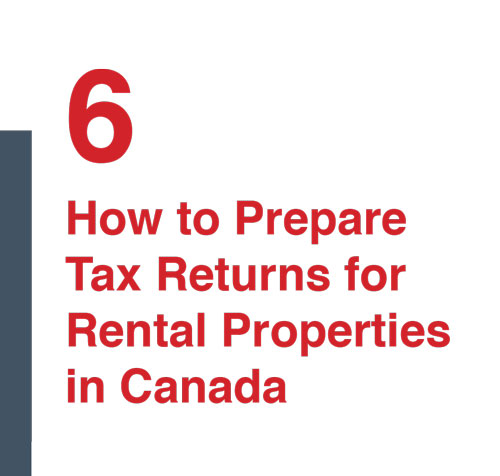
Do you own a rental property? If so, filing a tax return for a rental property that you own in Canada can be a difficult process. The following five steps can help you prepare a tax return for your real estate investment:
Step 1: Complete Form T776, Statement of Real Estate Rentals
Form T776 is used to report the income and expenses related to your rental property for tax purposes. It is an integral part of the tax return.
Step 2: Calculate Expenses
The following criteria must be used when determining which expenses are deductible:
> Expenses should be incurred for earning rental income
> The amount of the expenses should be reasonable
Step 3: Determine Rental Income
The gross rental revenue earned in the year must be reported on Form T776. It is equal to the number of rent payments received in the year, less prepaid rent received. Prepaid rent is not rental income, but is a tenant deposit that you are holding onto.


It is only recognized as revenue when it is applied to the month to which the prepaid rent relates.
Step 4: Claim Capital Cost Allowance (CCA)
The Capital Cost Allowance is an annual tax-write off calculated as a percentage of the cost of the property.
Step 5: Capital Gain or Terminal Loss
When you sell your rental property, you will either have a capital gain or a terminal loss. Half of a capital gain is taxable. When there is a loss on the property, it is recognized as a terminal loss that is fully deductible, and is entered on Form T776.
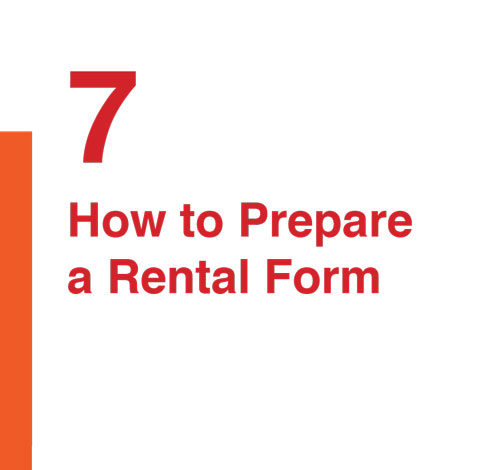
Rental Form T776 known as the Statement of Real Estate Rentals must be completed for each rental property that you own in Canada. This form is meant for investors that own rental properties in Canada and would like to file their tax returns independently. Follow these ten steps to help you prepare Form T776:
Step 1: Enter your name and social insurance number at the top of the form.
Step 2: Enter the start date, January 1 and the end date, December 31. If you acquired the property during the current tax year, then enter the date of acquisition as the start date.
Step 3: Enter your percentage of the ownership of the rental property.If there are other owners in addition to you, enter their details as well.
Step 4: Enter the address of the property and the number of units.
Step 5: Enter the gross rental income earned in the current year. This is the total of rent you charged your tenants.


Step 6: Enter the expenses incurred in the current year. Then enter the total of these expenses. If the entire property is rented out, and none of it is kept for your personal use, then enter $0 for the personal portion.
Step 7: Calculate the net income, which is the difference between the total income on line 6 and the deductible portion of the expenses on line 7.
Step 8: Calculate the Capital Cost Allowance, which is also known as tax depreciation.
Step 9: Enter the Capital Cost Allowance on line 16.
Step 10: Enter the Net Income after Capital Cost Allowance on line 17.
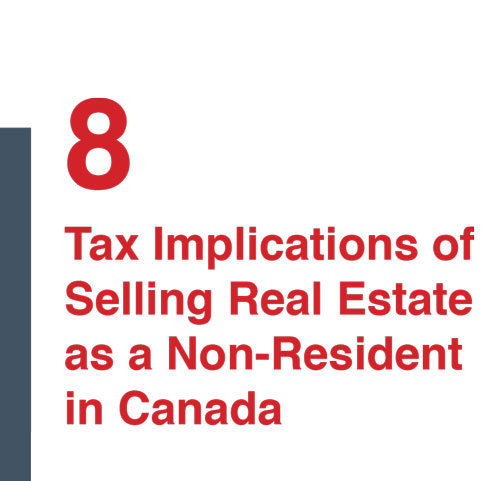
Non-residents must pay a federal tax of 25% of the gross selling price on the sale of Canadian real estate to the Canadian Revenue Agency.
Non-Resident Taxes
Canadian real estate appears very unattractive and costs are prohibitive. However, the federal tax of 25% on the gross selling price can be reduced to 25% on the capital gain realized on the sale of real estate in Canada. In order to have a reduced rate apply, the seller must first apply for a Clearance Certificate - Form T2062. It usually takes 4 to 8 weeks for the CRA to issue a Clearance Certificate.
Liability for Tax
The Canadian purchaser is liable for the 25% tax on the gross selling price on the sale of Canadian real estate to a non-resident of Canada. As such, the Canadian purchaser will usually withhold 25% from the gross selling price, until the CRA provides the purchaser with the Clearance Certificate. At that point, the purchaser will release the funds to the CRA and any excess funds will be returned to the non-resident seller.


Filing Tax Return for Sale of Real Estate in Canada
At the end of the year, the non-resident seller must file a Canadian income tax return to report the profit realized on the sale of Canadian real estate. Taxes that have already been remitted to the CRA will be credited on the tax return filed. Usually, a non-resident of Canada will receive a tax refund because of personal tax credits that are granted to them.
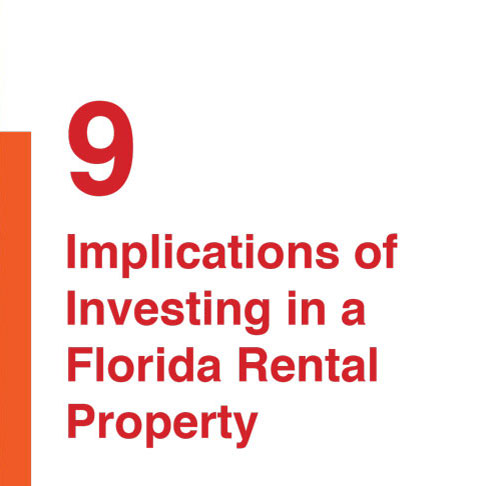
Thinking about making an investment in the sunshine state? There are a few things you should take note of when investing in a Florida rental property as a Canadian.
1. The Numbers
Become familiar with the income statement and its expected revenue and expense. This includes management and utility fees.
2. No Double Tax
As a Canadian resident, you are responsible for paying Canadian income taxes on your worldwide income. To prevent double taxation, you can claim a foreign tax credit on your Canadian return.
3. Taxable Income
You’ll notice that the taxable income for Canadian purposes is higher. This is because Canada provides a lower depreciation deduction than the US.
4. Taxes Payable
Every person receives a personal exemption of $4,050 in the US. This means that the taxable income below $4,050 is tax-free.
5. Depreciation
For US tax purposes, the cost of a property


(excluding land) can be depreciated over a period of 27.5 years. For Canadian tax purposes, depreciation of 4% of the cost of the property can be claimed each year except for the first year.
6. Withholding Tax
Non-residents that collect rent from a rental property in the US are subjected to a 30% withholding tax.
7. Filing U.S. Tax Return
Each year you will have to file a US non-resident tax return to report the rent collected and expenses incurred.
8. Capital Gains
If you sell your property, both capital gain and recapture of depreciation must be included in your income for US and Canadian tax purposes.
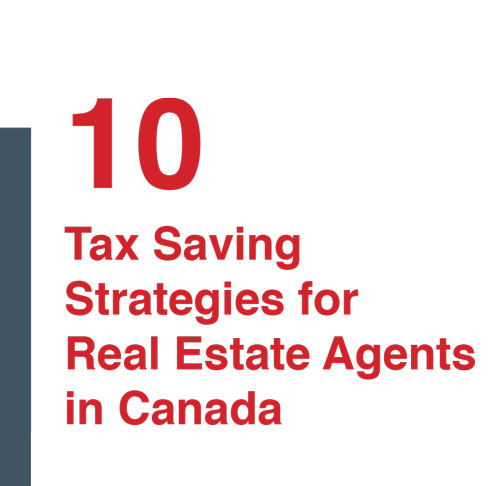
As a real estate agent in the top income tax bracket in the province of Ontario, you are paying tax at a rate of 53%. Wouldn’t it be nice if you could incorporate and pay tax at a rate of only 12.5%?
12.5% is the corporate income tax rate for small business corporations in Canada. Unfortunately, the Real Estate Council of Ontario (RECO) does not permit real estate agents to incorporate. By following a series of steps, this dilemma can be solved.
Step 1: Create a New Corporation
The first step entails creating a new corporation that is owned by your spouse. The new corporation will perform managerial services on behalf of you, the real estate agent.
Step 2: Determine Expenses
The second step is to identify the types of expenses that the managerial company will pay for and charge back to you. The expenses that you would ordinarily pay for include:
> Advertising, Marketing, Promotion
> Supplies, Rent
> Staff


> Computer Charges & Internet
> General Overheads
The above expenses should be charged back to you by your spouse’s corporation at a cost plus a mark-up of 15 to 25%.
Step 3: Charge for Labour
The third step is for your spouse’s corporation to bill you for time spent by the corporation’s staff on administering the marketing, administration and other functions on your behalf.
Step 4: Write Monthly Cheques to Management Corporation,
The fourth step is for you to write a monthly cheque to your spouse’s management corporation for the services performed that month.
About the Author

Allan Madan is a CPA, CA, and international tax expert. He is a graduate of the University of Waterloo where he earned a Masters Degree in accounting. He enjoys working with business owners, entrepreneurs and individuals. Allan has over 10 years of experience in public accounting. Prior to founding Madan Chartered Accountant in Mississauga, he worked for the Deloitte firm where he was the International Tax Manager. He has completed Parts 1 and 2 of the Canadian In Depth Tax Course, which is the most comprehensive tax training in Canada.
About the Company

At Madan Chartered Accountant, we know how important the experience is. We also know how critical it is to have someone in your corner that knows your unique situation. Your taxes are important to us, because they are important to you. Our knowledgeable and friendly staff will always take the time to go the extra mile. Among all the accounting firms in Mississuga, we’re special. Our unique size enables us to answer the most complex of problems, yet provide personal attention to all our clients.
Contact Us:
Address:
145 Traders Boulevard East, Unit 20
Mississauga, ON L4Z 3L3
Phone: (905) 268-0150
© 2018 Madan Chartered Accountant Professional Corporation. All Rights Reserved.

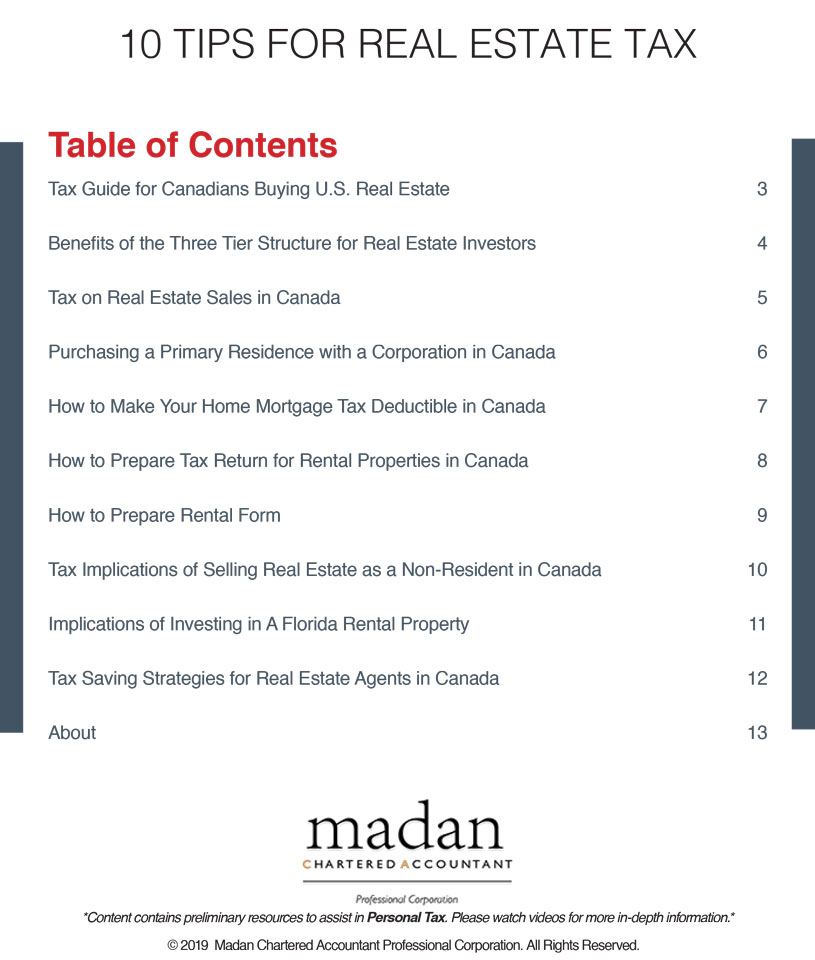

SOCIAL CONNECT